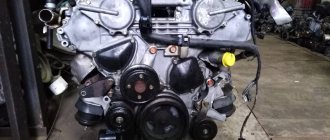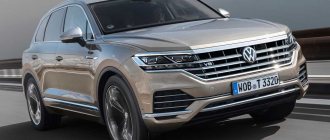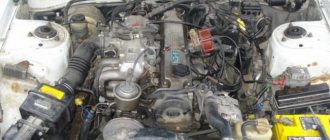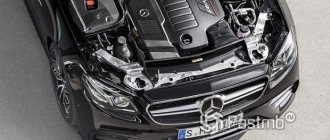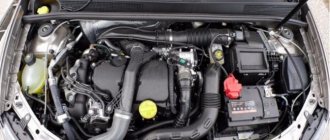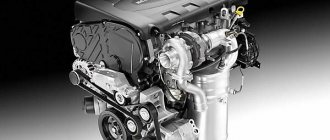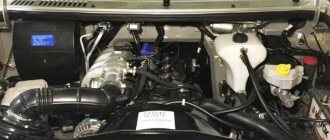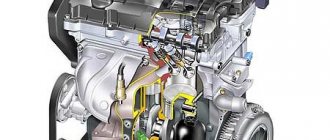Characteristics of 2.0 TDI EA189 engines
| Production | Volkswagen |
| Engine make | 2.0 TDI EA189 |
| Years of manufacture | 2007-2016 |
| Cylinder block material | cast iron |
| engine's type | diesel |
| Configuration | in-line |
| Number of cylinders | 4 |
| Valves per cylinder | 4 |
| Piston stroke, mm | 95.5 |
| Cylinder diameter, mm | 81 |
| Compression ratio | 16.5 |
| Engine capacity, cc | 1968 |
| Engine power, hp/rpm | 84/3500 102/3500 110/4200 114/3500 140/4200 143/4200 150/4200 163/4200 170/4200 177/4200 180/3500 |
| Torque, Nm/rpm | 220/1250-2500 250/1500-2500 250/1500-2500 250/1500-2750 320/1750-2500 320/1750-2500 320/1750-2500 400/1750-2500 350/1750-2500 380/1750-2500 400/1500-2000 |
| Environmental standards | Euro 4 Euro 5 |
| Turbocharger | BorgWarner BV40 BorgWarner BV43 Garrett GTC1446VZ Garrett GTC1459MVZ Garrett GTC1549MVZ |
| Engine weight, kg | 165 |
| Fuel consumption, l/100 km (for Golf 6) - city - highway - mixed. | 6.34.1 4.9 |
| Oil consumption, g/1000 km | up to 500 |
| Engine oil | 5W-30 |
| How much oil is in the engine, l | 4.3 |
| Oil change carried out, km | 15000 (better 7500) |
| Engine operating temperature, degrees. | — |
| Engine life, thousand km - according to the plant - in practice | — 350+ |
| Tuning, hp — potential — without loss of resource | 200+ — |
| The engine was installed | VW Caddy Volkswagen Golf VW Jetta Volkswagen Passat VW Passat CC VW Tiguan Audi A3 Audi A4 Audi A5 Audi A6 Audi Q3 Audi Q5 Skoda Octavia Skoda Superb Skoda Yeti Audi A1 Audi TT VW Eos VW Beetle VW Scirocco Volkswagen Sharan VW Touran SEAT Alhambra SEAT Altea SEAT Exeo SEAT Ibiza SEAT Leon |
PSA / Ford 2.0 HDi / TDCi
Remember the code “DW10” - under this designation PSA engineers hid a two-liter diesel engine with a Common Rail power system. It appeared in 1998 and is still offered today, for example, in the Peugeot 5008.
At the beginning of the twentieth century, the 2.0 HDi was head and shoulders above the Volkswagen turbodiesel with pump injectors in terms of operating culture. True, we had to take into account higher fuel consumption, but the driving pleasure was incomparable.
2.0 HDi can be found not only in PSA and Ford cars, but also in Suzuki, Volvo and cars of other brands. It was often recommended as the best engine for this model.
The 2-liter diesel has been on the market for over twenty years and, of course, has undergone a number of changes. The huge number of variations can cause problems with the selection of spare parts, but almost anything can be bought for these engines!
Age and huge mileages force us to reckon with malfunctions. In older versions, injectors fail quite often (every 150-200 thousand km). In newer ones, leaks appear through the high-pressure pump, sometimes the pump drive fails, and the engine begins to operate intermittently.
On the 16-valve version, a hum in the valve cover area may indicate the need to replace the short chain connecting the camshafts. The intake camshaft is driven by a toothed belt. Belt replacement is recommended after a maximum of 200,000 km.
A typical nuisance that creates problems for mechanics unfamiliar with the “French” is an antifreeze leak in the area of the EGR valve. The coolant evaporates, but the oil does not arrive. In addition, “little things” like the turbocharger control valve and the dual-mass flywheel fail.
Many versions are equipped with a wet particulate filter that requires replenishment of Eolys fluid. This filter has a limited lifespan and must be replaced.
Application:
Ford Kuga - a 2-liter diesel engine was used by the first generation of the model.
Peugeot 407 – well-maintained Peugeot 407 2.0 HDi – a tasty morsel on the secondary market. It is reasonably priced and is inexpensive to maintain.
Volvo V70 - in 2007-2016 there are two versions of the 2-liter turbodiesel: the described 4-cylinder and 5-cylinder (Volvo’s own development).
Reliability, problems and repair of VW 2.0 TDI
In 2007, a new 2.0 TDI of the EA189 family was released and it was created on the basis of the previous 2-liter EA188 engine. The new engine was ordered to replace the 2.0 TDI and 1.9 TDI EA188. Here is the same cast-iron cylinder block, with a forged crankshaft with a stroke of 95.5 mm, the cylinder diameter is 81 mm, inside there are pistons of a redesigned design, their height is 45.8 mm.
An aluminum head with 16 valves and two camshafts is installed on top of the block. The diameter of the intake valves is 28.1 mm, the exhaust valves are 26 mm, the stem thickness is 6 mm. The timing drive uses a belt that lasts 120 thousand km (it is advisable to check at 90 thousand km). The main difference between the new cylinder head is the transition from pump injectors to common rail from Bosch (injection pressure 1800 bar). Piezo injectors are immediately used here, and a plastic manifold with swirl flaps is installed at the inlet, which fully open at 3000 rpm. The engine is controlled by a Bosch EDC 17 CP14 ECU. These diesel engines are equipped with a BorgWarner BV43 turbine.
In 2009, they released the updated generation EA189 2.0 diesel, where they removed the dampers in the intake manifold, replaced the piezo injectors with electromagnetic ones, and installed a Bosch EDC 17 C46 ECU. BorgWarner BV40 and BV43 turbines are used here.
All these engines had about 50 different designations, showed different power, and were equipped or not equipped with balancer shafts. Their main differences are described below.
Junior models were created based on the EA189 2.0 TDI: 1.6 TDI and 1.2 TDI.
In 2015, these engines were replaced by the next generation 2.0 TDI EA288.
Differences between 2.0 TDI Common rail engines
1. CBAA (2007 - 2010) - 136 hp diesel, analogue of CBAB with different firmware. 2. CBAB (2008 - 2011) - engine with BV43-1874KXB419.18KVAXC turbine and balancer shafts. Its power is 140 hp. 3. CBAC (2009 - 2010) - another CBA engine with 143 hp firmware. 4. CBDA (2008 - 2010) - an analogue of CBAA without balancer shafts. 5. CBDB (2008 -2015) - the same CBAB without balancing shafts. 6. CBDC (2008 - 2009) - motor without balancing shafts with firmware for 110 hp. 7. CBBA (2008 - 2011) - 163 hp engine, analogue of CBBB. 8. CBBB (2008 - 2012) - 170 hp engine. with a slightly enlarged turbine BV43-1880KCF419.18BVAXC and other injectors. 9. CEGA (2009 - 2015) - analogue of CBBB without balancing shafts. 10. CFHA (2009 - 2015) - 2nd generation EA189 engine with 110 hp. 11. CFHB (2009 - 2015) - the same CFHA with 136 hp firmware. 12. CFHC (2009 - 2015) - 2nd generation engine replacing the CBDB with a BV40-1874KCB340.18AVAXC turbine, which has a power of 140 hp. 13. CFHD (2010 - 2015) - replacement for CBAC, the power is the same - 143 hp. 14. CFHE (2010 - 2015) - version for VW Caddy with 85 hp. 15. CFHF (2009 - 2015) - an analogue of CFHA for all-wheel drive vehicles. 16. CFFA (2009 - 2015) - the same CFHB, but with balancing shafts. ICE has replaced CBAA. 17. CFFB (2009 - 2015) - analogue of CFHC with balancer shafts. The motor replaced the CBAB. 18. CFFD (2010 - 2016) is a CFHA with balancer shafts. 19. CFFE (2011 - 2015) - 116 hp version. for Sharan and Alhambra. 20. CFGB (2010 - 2015) - 2nd generation engine with a Garrett GTC1549MVZ turbine, which replaced the CBBB and has a power of 170 hp. 21. CFGC (2011 - 2015) - the same engine with firmware for 177 hp. 22. CFJA (2010 - 2015) - second generation engine, replaced CEGA and has the same 170 hp. 23. CFJB (2012 - 2015) - CFJA engine with 177 hp firmware. 24. CLJA (2010 - 2015) - 2nd generation diesel engine with balancer shafts, without particulate filter and Euro-4 compliant. Power 140 hp 25. CLCA (2009 - 2015) - the same CLCB, but the power is reduced to 110 hp. 26. CLCB (2009 - 2015) - variation of CLJA without balancer shafts, for Euro 4 standards. 27. CBEA (2007 - 2009) - version for American environmental standards of the 1st generation with balancer shafts with a power of 140 hp. 28. CJAA (2009 - 2014) - analogue of CBEA for the USA without balancer shafts, the power is the same. 29. CKRA (2011 - 2014) - 2nd generation with balancer shafts, released for the North American market. 30. CAHA (2008 - 2013) - engine for Audi with 170 hp. with balancer shafts, with a BV43-1880KCF419.18BVAXC turbine and with a Bosch EDC 17 CR ECU for Euro 4. 31. CAHB (2008 - 2012) - analogous to CAHA, but upgraded to 163 hp. 32. CAGA (2007 - 2013) - engine for Audi with balancer shafts and a BV43-1874KXB419.18KVAXC turbine. Power - 143 hp. 33. CAGB (2008 - 2015) - analogue of CAGA with a power of 136 hp. 34. CAGC (2008 - 2013) - the same CAGA, but the power is reduced to 120 hp. 35. CGLB (2010 - 2013) - second generation EA189 for Audi with turbine BV43-1880KCF419.18BVAXC, power 170 hp. 36. CGLC (2011 - 2015) - the same version with 177 hp. 37. CGLD (2011 - 2015) - version of the CGL with 163 hp. 38. CJCA (2011 - 2013) - second generation for Audi with a Garrett GTC1446VZ turbine and 143 hp. 39. CJCB (2012 - 2015) - similar to CJCA, but with 136 hp firmware. 40. CJCC (2012 - 2015) - the same model with 120 hp. 41. CJCD (2013 - 2015) - 150 hp version of the CJC. 42. CAAA (2009 - 2016) - engine for VW T5 with 84 hp. A Garrett GTB1446VZ turbine and a Bosch EDC 17CP 20.43 ECU are installed here. CAAB (2009 - 2016) - an analogue of CAAA with 102 hp firmware. 44. CAAC (2009 - 2016) - analogue of CAAA with 140 hp. 45. CAAD (2011 - 2015) - 114 hp version. 46. CCHA (2009 - 2015) - the same CAAC, but with balancer shafts. 47. CFCA (2009 - 2016) - this is the twin-turbo version. It features a cylinder block with improved cooling, a different oil pump, modified pistons, and a modified thermostat. A two-stage BorgWarner R2S supercharging system is installed here, which consists of K04 and KP35 turbines, and the whole thing is controlled by a Bosch EDC 17CP 20 ECU. This engine develops 180 hp. and 400 Nm at 1500-2000 rpm. 48. CLLA (2010 - 2012) - engine with a Garrett GTC1459MVZ turbine, its output is 170 hp. 49. CLLB (2011 - 2015) - a similar model with firmware for 177 hp.
Problems and reliability of Volkswagen 2.0 TDI
These are excellent engines that have virtually no weak points. Versions with balancer shafts produced before the end of 2009 have a problem with the hexagon of the oil pump, which must be changed at mileages of up to 200 thousand km, otherwise the oil pressure will drop with all the consequences for the engine. Engines with swirl flaps in the intake manifold have a problem with these flaps sticking due to contamination. Approximately every 100 thousand km you need to clean the intake manifold with EGR or turn off this valve, remove the flaps and flash the ECU. Otherwise, with good and regular maintenance, the service life of a 2-liter TDI with Common rail is more than 350-400 thousand km.
Fiat Group 1.6/2.0 Multijet
The two-liter diesel engine, created by the Fiat Group, had an easy time entering the market. Its predecessor (1.9 JTD) received many positive reviews. In addition, the design of the diesel 1.9 formed the basis for the new 2.0. But there are enough changes. The attachments have been updated and all versions have 16 valves.
In 2008, both versions debuted - 1.6 and 2.0. The engines ended up under the hood of a huge number of cars - Alfa Romeo, Fiat, Suzuki, Opel, Jeep. Despite the fact that the Italian turbodiesel has proven itself well, there are still problems. Some of them require timely resolution, as they can lead to costly breakdowns or even destruction of the engine.
First of all, we are talking about problems with the coolant pump. Leaks occur or the impeller becomes deformed. The latter is fraught with excessive load on the timing belt. The wear of the seals in the lubrication system also makes itself felt. In this case, the oil pressure light periodically lights up, and eventually begins to burn constantly.
Other problems are “eternal” updates in Opel models, problems with the DPF filter, and turbine failure. If faults are corrected in a timely manner, large repair costs will not be required.
Application:
Alfa Romeo Giulietta – under the hood you will find both 1.6 and 2.0 diesel engines. The range of covered power is from 105 to 175 hp.
Opel Insignia - 2-liter turbodiesel had many power options, peak 190 and 195 hp. - in biturbo.
Suzuki Vitara - in some markets it received a 1.6 liter Fiat diesel engine.
Tuning 2.0 TDI engines
Chip tuning
Versions for 110, 136 and 140 hp. on Stage 1 firmware they give 180 hp. and closer to 400 Nm of torque. With a downpipe and intake, you can achieve 190 hp. and +20 Nm of torque. More powerful models with 170, 163 and 177 hp, only on firmware, allow you to get a little over 200 hp. and torque 400-420 Nm. By installing an intake and downpipe, you will get 210+ hp. and torque 420+ Nm. If you suddenly want to upgrade your diesel VW Transporter with a biturbo engine, you can count on 215 hp. and 430-440 Nm of torque.
ENGINE RATING: 5-
<<BACK
Honda 2.2 (N22A/N22B)
This is one of the most durable diesel engines of recent years. Initially it acted as the 2.2 i-CTDi (volume 2204 cm3 and labeled N22A), and later as the 2.2 i-DTEC (2199 cm3, N22B). Yes, in the first there are problems with the pulleys, and the exhaust manifold can also burst, and in the second the DPF particulate filter often gets clogged. But this is a small baggage of problems, especially compared to competitors. Injectors, piston system, cylinder head, dual-mass flywheel - these components are highly durable.
Application:
Honda Civic - 2.2 / 140 hp the only diesel in the range of power units of the model.
Honda FR-V – van with a reliable 2.2 / 140 hp diesel engine. may still be an attractive proposition for a family.
Honda CR-V - the third generation crossover used both diesel options.
BMW 2.0 R4 turbo (N20)
This engine was intended to replace the naturally aspirated R6s while retaining power and lower fuel consumption. Theoretically, of course. The engine received direct fuel injection, double Vanos, a Valvetronic valve lift system, a Twin Scroll turbine, an electric pump, and an aluminum block and head.
Malfunctions? Oil pump drive. The chain begins to make noise, and if the symptoms are ignored, this will ultimately lead to the death of the motor. The repair consists of replacing the drive and the oil pump itself.
The timing chain also fails, which has already become a tradition at BMW. The chain may become noisy after 40-60 thousand km. Replacement will require about 30-50 thousand rubles.
Power options: 156 hp (18i), 184 hp (20i), 218 hp (25i), 245 hp (28i).
BMW 3.0 R6 Turbo (N54/N55)
The N54 and N55 engines have a similar design. The first debuted back in 2006 and was in production until 2012, while the N55 was available between 2009 and 2015. The engines are an in-line six with a volume of 2979 cm3, have direct fuel injection, a Valvetronic valve lift control system and turbocharging. The N54 used two small Mitsubishi turbos, while the N55 used a single Twin Scroll turbo. Almost every 2006-2015 BMW with the 35i end (for example, 135i, 335i, X3 35i, as well as 1M Coupe) was equipped with N54 / N55. Power range 306-400 hp. The strongest ones were reserved for the Alpina (with Mahle forged pistons).
In terms of driving characteristics, both engines are excellent. N54 turned out to be quite vulnerable. The injectors and high-pressure fuel pump regularly suffered, carbon deposits accumulated in the intake manifold (cleaning is necessary every 80-100 thousand km), and the turbine bypass valve failed (replacement or repair of the turbine).
The N55 engine performed significantly better. The injectors have become more durable, and problems with the turbine have decreased. The bad news is that in units whose owners followed the manufacturer's recommended oil change intervals of every 30,000 km, the connecting rod bearings wore out in the long term. A typical sign of a malfunction is a knocking or clattering sound when the speed increases. Repairs are certainly not cheap. A good workshop will ask for around 50-80 thousand rubles.
VW 1.8T and 2.0T (EA888)
The 1.8 and 2.0 T(F)SI engines of the EA888 family appeared on the market in 2007. They are powerful and economical. However, some copies ended up on the secondary market due to upcoming repairs. The 1.8 and 2.0 TSI (TFSI) engines used piston rings that were too weak, which subsequently led to increased oil consumption. In extreme cases, the turbo engine consumed more than 1 liter of oil per 1000 km. Major repairs are very expensive - from 50 to 150 thousand rubles. The number of problems associated with increased oil consumption has decreased significantly in modernized engines produced after 2011 - EA888 gen. 3 and 3B.
Volvo 2.0 D R5
Among Volvo diesel engines you can find PSA and Ford engines (1.6 and 2.0), as well as original Volvo in-line “fives” and “fours”. What should you pay attention to?
The most risky choice among diesel units in recent years is a 2-liter with 5 cylinders and code D520. Commercial designation D3 and D4. Sometimes their cylinder block bursts. However, this is not a common defect. Sometimes it breaks through the gasket under the head of the block.
In addition to these problems, Volvo diesel engines also contain defects that are typical for modern units of this type. These include turbocharger malfunctions. While in many models this is a minor problem, in engines with two turbos they are packed so tightly that it is easier to remove the entire engine to remove the supercharger.
A typical problem with many diesel Volvos is the drive belt of attached units, which can break and get under the timing belt, which disables the entire engine.
Another problem concerns the burning of the particulate filter. Quite often it turns out that the car is not able to cope with this on its own, and specialist intervention is required.
In terms of technology, Volvo diesels stand out with their 5-cylinder design and 20 valves. Since 2001, all diesel engines have used the Common Rail injection system. In 2009, piezoelectric injectors appeared, the compression ratio was lowered, and the injection pressure was increased to 1800 bar. More and more modifications are getting two turbochargers instead of one. The timing belt is driven by a toothed belt with a recommended replacement period of 160-180 thousand km.
Engine life, problems and fuel consumption
A diesel engine of this type has a recommended mileage of 200,000 km. This is not the maximum resource, since with a successful combination of circumstances it can be even greater (mileages of 300-450 thousand have been recorded and they are still working). Its reliability directly depends on driving style, operating conditions and the quality of the consumables used. It is worth noting that the engine spent its maximum life on original oils and filters.
The design features of the engine are very sensitive to the quality and composition of the lubricants used, increased speeds and loads, and therefore the large heat generation must be compensated by oil cooling without the formation of soot. The breakthrough of crankcase gases and oil vapors through the ventilation system, the presence of oil deposits in the intake manifold, can disrupt the normal operation of the internal combustion engine. The recommended oil is synthetic 5W-30, suitable for normal to medium-heavy operating conditions. Filling volume – 4.3 liters with a cleaning filter, replacement – optimal 10,000 km, under severe conditions of use – 7,500 km. When using original oils, flushing the engine with detergent additives is not recommended.
Note. Turbocharged diesel engines have an acceptable oil consumption and in this case it is 500 grams per thousand. With high mileage and long trips, waste can reach up to 1 liter/thousand. At higher flow rates, it is necessary to diagnose the turbine, the condition of the seals, piston group and valve stem seals.
The maintainability of this engine is at a sufficient level; boring and repair dimensions of the CPG are quite acceptable. Sometimes cylinder head problems arise, the cooling partitions between the valves burst, and therefore cannot be repaired and a complete replacement is required. When using inappropriate fuel, you can observe burnout of pistons and valves, up to the appearance of detonation and mechanical destruction of the skirts. Particular attention should be paid to the timing belt, idler and tension rollers, since if the teeth are broken or damaged, serious repairs to the cylinder head are guaranteed.
Replacing the belt must be carried out using special instruments, since the engine control system has a very accurate and sensitive diagnostic program, where any deviations from the norm are strictly defined. If installed “by eye or by marking”, the timing phases will be outside the error limit and the engine will not operate correctly. It is possible to carry out maintenance of the catalyst and particulate filter with the possibility of regeneration independently, using the instructions, but still the best effect is achieved by cleaning using dealer equipment and a special program.
One of the advantages of the VW 2.0 TDI is its low fuel consumption in relation to the transported weight. A consumption of 4-5 liters for medium-sized cars and 6-7 for large-sized ones is the norm, under normal operating conditions. Any increase in consumption, if it is not temporary or seasonal, is a reason to conduct a comprehensive diagnosis of the engine and auxiliary systems. It is worth noting that the BC readings regarding fuel consumption are always underestimated and are not objective, but rather advisory in nature. True consumption depends on much larger factors, many of which are not included in the calculations.

